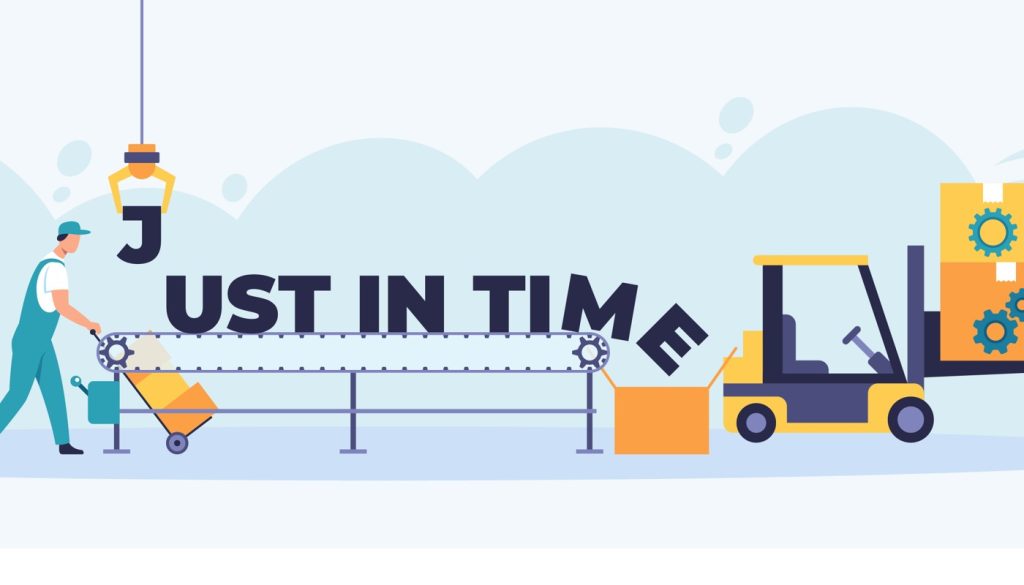
What is Just-in-Time (JIT) Inventory Management?
Just-in-Time (JIT) inventory management is a strategy aimed at minimizing waste and improving efficiency by receiving goods only when needed. Businesses using JIT keep inventory levels low, reducing storage costs and the risk of excess inventory. This approach requires precise planning and timing, as materials must arrive just before they are needed for production or sales. JIT eliminates the need for significant warehousing by closely aligning supply with demand.
The origins of the Just-in-Time system trace back to Toyota in the 1950s. Taiichi Ohno developed Toyota’s manufacturing process to reduce inefficiencies and boost productivity by producing only what was needed. This method evolved into the Toyota Production System (TPS) and later became the broader concept of JIT, adopted by industries worldwide. JIT’s core principles emphasize reducing waste in time, materials, and labor while improving responsiveness to demand.
By lowering excess inventory, Just-in-Time helps businesses avoid costs associated with warehousing unsold products and product obsolescence. The system also increases production flexibility, enabling quick responses to market changes or consumer demand. However, JIT relies on strong supplier relationships and dependable logistics to ensure materials arrive on time. While JIT offers cost reduction and efficiency benefits, its success depends on careful coordination and the ability to manage unexpected supply chain disruptions.
Benefits of Implementing Just-in-Time Inventory Systems
Implementing Just-in-Time inventory systems offers significant benefits for businesses, including cost reduction, improved cash flow, and streamlined operations. One key advantage is reducing inventory carrying costs. By holding minimal stock, businesses save on warehousing, insurance, and depreciation expenses. This approach also prevents overproduction and reduces waste, lowering the risk of product obsolescence.
Another benefit of Just-in-Time systems is improved cash flow. With less money tied up in inventory, businesses free capital for innovation or expansion. Purchasing materials only when needed reduces the financial burden of bulk buying or maintaining large stockpiles. This allows for more flexible cash management, aligning spending with actual demand and avoiding unnecessary costs.
In addition, Just-in-Time systems streamline production by eliminating inefficiencies. Receiving materials when required reduces lead times and optimizes labor and equipment use. This precision enables businesses to focus on continuous improvement and lean operations, leading to faster production cycles. As a result, companies can respond more quickly to market changes and align production with demand, reducing bottlenecks and fostering agility. This approach allows businesses to stay competitive and better manage resources in a dynamic market environment.
Challenges and Risks
While Just-in-Time inventory systems offer significant benefits, they also come with certain challenges and risks that businesses must address. One of the main risks is the potential for supply chain disruptions. Because JIT relies on materials arriving exactly when needed, any delay—whether due to transportation issues, supplier shortages, or natural disasters—can halt production and lead to costly downtime. This vulnerability became evident during the COVID-19 pandemic when many global supply chains were disrupted, causing delays and shortages for businesses that relied on JIT systems.
Another challenge with Just-in-Time is the heavy reliance on suppliers. In a JIT model, businesses depend on their suppliers to deliver materials promptly and consistently. If a supplier encounters production issues or delays, it can create a domino effect, impacting the entire supply chain. This reliance leaves companies exposed to external risks beyond their control, such as economic instability or trade restrictions, which can further disrupt the flow of goods. Additionally, JIT makes businesses more vulnerable during crises, as they lack large stockpiles to fall back on in case of sudden increases in demand or unexpected disruptions.
To mitigate these risks, businesses using Just-in-Time inventory systems must adopt strategies to build greater resilience. One approach is to diversify suppliers, reducing dependence on a single source for critical materials. By having backup suppliers or geographically distributed partners, companies can ensure continuity even if one supplier faces issues. Additionally, investing in real-time data analytics and supply chain monitoring tools can help businesses anticipate potential disruptions and respond quickly. Establishing strong relationships with suppliers and regularly reviewing contracts can also help ensure reliability and flexibility. While JIT systems present challenges, proactive risk management strategies can help businesses minimize disruptions and maintain operational efficiency.
Just-in-Time vs. Traditional Inventory Management: Key Differences
Just-in-Time (JIT) inventory management differs significantly from traditional inventory systems in its approach to stock levels and replenishment. In traditional systems, businesses typically hold large amounts of inventory to ensure they can meet customer demand and avoid stockouts. This method provides a buffer against supply chain delays but ties up capital in unsold products and requires more storage space. In contrast, JIT focuses on receiving inventory only when it is needed for production or sales, minimizing storage costs and reducing waste from excess stock. The goal of JIT is to create a leaner, more efficient operation.
A key difference between Just-in-Time and traditional methods like Economic Order Quantity (EOQ) or bulk purchasing is the timing and quantity of inventory orders. EOQ focuses on optimizing order sizes to minimize total inventory costs, including holding and ordering costs. Businesses using EOQ often purchase large quantities to benefit from economies of scale, reducing the per-unit cost of goods. Similarly, bulk purchasing involves ordering large quantities at once to take advantage of discounts, but it leads to higher storage costs and potential for overstocking. JIT, on the other hand, emphasizes ordering smaller quantities more frequently, ensuring that materials arrive just in time for production without the need for large storage facilities.
The contrast between Just-in-Time and traditional inventory systems highlights the trade-off between flexibility and stability. Traditional methods provide a safety net by holding extra stock, which can be advantageous during periods of unpredictable demand or supply chain disruptions. However, they also increase operational costs and the risk of obsolete inventory. JIT, while more cost-efficient in reducing storage and waste, requires precise coordination and reliable suppliers. Businesses must choose between these methods based on their operational needs, market conditions, and supply chain reliability.
How Technology Supports Just-in-Time Systems
Technology plays a vital role in enabling Just-in-Time inventory systems, allowing businesses to achieve the required precision and efficiency. Inventory tracking software is crucial for JIT, providing real-time visibility into stock levels and material flow. This technology helps monitor inventory movement, ensuring materials are reordered just in time for production without holding excess stock. By automating these processes, businesses reduce the risk of stockouts and overstocking, improving supply chain efficiency.
Data analytics also optimizes Just-in-Time operations by analyzing historical sales data and demand trends. This helps businesses accurately forecast future needs and adjust ordering schedules accordingly. Predictive analytics enables companies to anticipate changes in demand, ensuring they have the right materials at the right time. Real-time data integration from suppliers allows businesses to respond quickly to potential disruptions, reducing delays. Advanced analytics also help companies identify inefficiencies in supply chains, further optimizing processes to reduce costs and lead times.
Automation enhances Just-in-Time systems by streamlining operations and reducing manual tasks. Automated ordering systems trigger replenishment based on predefined inventory levels, ensuring that businesses order materials when needed. This reduces human error and ensures processes run smoothly. Technologies like robotics and AI-driven warehouse management systems optimize picking, packing, and shipping, crucial for maintaining the speed required for JIT. Integrating technology into JIT operations helps businesses achieve greater accuracy, flexibility, and responsiveness, ensuring a more cost-effective supply chain.
Conclusion
In conclusion, Just-in-Time inventory management offers businesses a way to reduce costs, improve cash flow, and streamline production processes. However, it requires precise coordination, strong supplier relationships, and the ability to quickly adapt to potential disruptions. Leveraging technology like inventory tracking, data analytics, and automation can significantly enhance the effectiveness of JIT systems, allowing companies to optimize operations and stay competitive. While challenges exist, businesses that successfully implement JIT can achieve greater efficiency and responsiveness in their supply chains, positioning themselves for long-term success in an evolving market.


